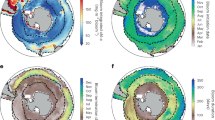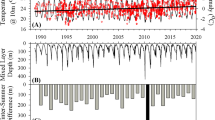Abstract
Climate change will unquestionably influence global ocean plankton because it directly impacts both the availability of growth-limiting resources and the ecological processes governing biomass distributions and annual cycles. Forecasting this change demands recognition of the vital, yet counterintuitive, attributes of the plankton world. The biomass of photosynthetic phytoplankton, for example, is not proportional to their division rate. Perhaps more surprising, physical processes (such as deep vertical mixing) can actually trigger an accumulation in phytoplankton while simultaneously decreasing their division rates. These behaviours emerge because changes in phytoplankton division rates are paralleled by proportional changes in grazing, viral attack and other loss rates. Here I discuss this trophic dance between predators and prey, how it dictates when phytoplankton biomass remains constant or achieves massive blooms, and how it can determine even the sign of change in ocean ecosystems under a warming climate.
This is a preview of subscription content, access via your institution
Access options
Subscribe to this journal
Receive 12 print issues and online access
$209.00 per year
only $17.42 per issue
Buy this article
- Purchase on Springer Link
- Instant access to full article PDF
Prices may be subject to local taxes which are calculated during checkout





Similar content being viewed by others
References
Behrenfeld, M. J. & Falkowski, P. G. Photosynthetic rates derived from satellite-based chlorophyll concentration. Limnol. Oceanogr. 42, 1–20 (1997).
Field, C. B., Behrenfeld, M. J., Randerson, J. T. & Falkowski, P. G. Primary production of the biosphere: integrating terrestrial and oceanic components. Science 281, 237–240 (1998).
Antoine, D., André, J. M. & Morel, A. Oceanic primary production: II. Estimation at global scale from satellite (Coastal Zone Color Scanner) chlorophyll. Glob. Biogeochem. Cycles 10, 57–69 (1996).
Chassot, E. et al. Global marine primary production constrains fisheries catches. Ecol. Lett. 13, 495–505 (2010).
Takahashi, T. et al. Climatological mean and decadal change in surface ocean pCO2 and net sea–air CO2 flux over the global oceans. Deep-Sea Res. II 56, 554–577 (2009).
Alkire, M. B. et al. Estimates of net community production and export using high-resolution, Lagrangian measurements of O2, NO3−, and POC through the evolution of a spring diatom bloom in the North Atlantic. Deep-Sea Res. I 64, 157–74 (2012).
Siegel, D. A. et al. Global assessment of ocean carbon export by combining satellite observations and food-web models. Glob. Biogeochem. Cycles 28, 181–196 (2014).
Behrenfeld, M. J. Abandoning Sverdrup's critical depth hypothesis on phytoplankton blooms. Ecology 91, 977–989 (2010).
Boss, E. & Behrenfeld, M. J. In situ evaluation of the initiation of the North Atlantic phytoplankton bloom. Geophys. Res. Lett. 37, L18603 (2010).
Behrenfeld, M. J., Doney, S. C., Lima, I., Boss, E. S. & Siegel, D. A. Annual cycles of ecological disturbance and recovery underlying the subarctic Atlantic spring plankton bloom. Glob. Biogeochem. Cycles 27, 526–540 (2013).
Behrenfeld, M. J. & Boss, E. S. Resurrecting the ecological underpinnings of ocean plankton blooms. Annu. Rev. Mar. Sci. 6, 167–194 (2014).
Taylor, J. R. & Ferrari, R. Ocean fronts trigger high latitude phytoplankton blooms. Geophys. Res. Lett. 38, L23601 (2011).
Taylor, J. R. & Ferrari, R. Shutdown of turbulent convection as a new criterion for the onset of spring phytoplankton blooms. Limnol. Oceanogr. 56, 2293–2307 (2011).
Mahadevan, A., D'Asaro, E., Lee, C. & Perry, M. J. Eddy-driven stratification initiates North Atlantic spring phytoplankton blooms. Science 337, 54–58 (2012).
Banse, K. Reflections about chance in my career, and on the top-down regulated world. Annu. Rev. Mar. Sci. 5, 1–19 (2013).
Sverdrup, H. U. The place of physical oceanography in oceanographic research. J. Mar. Res. 14, 287–294 (1955).
McClain, C. R. A decade of satellite ocean color observations. Annu. Rev. Mar. Sci. 1, 19–42 (2009).
Behrenfeld, M. J. et al. Climate-driven trends in contemporary ocean productivity. Nature 444, 752–755 (2006).
Siegel, D. A. et al. Regional to global assessments of phytoplankton dynamics from the SeaWiFS mission. Remote Sens. Environ. 135, 77–91 (2013).
Banse, K. Rates of phytoplankton cell division in the field and in iron enrichment experiments. Limnol. Oceanogr. 36, 1886–1898 (1991).
Riley, G. A. Factors controlling phytoplankton populations on Georges Bank. J. Mar. Res. 6, 54–73 (1946).
Riley, G. A. & Bumpus, D. F. Phytoplankton–zooplankton relationships on Georges Bank. J. Mar. Res. 6, 33–47 (1946).
Cushing, D. H. The seasonal variation in oceanic production as a problem in population dynamics. J. Cons. Int. Explor. Mer. 24, 455–464 (1959).
Banse, K. in Primary Productivity and Biogeochemical Cycles in the Sea (eds Falkowski, P. G. & Woodhead, A. D.) 409–440 (Plenum, 1992).
Vaulot, D., Marie, D., Olson, R. J. & Chisholm, S. W. Growth of Prochlorococcus, a photosynthetic prokaryote, in the equatorial Pacific Ocean. Science 268, 1480–1482 (1995).
Vaulot, D. & Marie, D. Diel variability of photosynthetic picoplankton in the equatorial Pacific. J. Geophys. Res. 104, 3297–3310 (1999).
Martinez, E., Antoine, D., D'Ortenzio, F. & Gentili, B. Climate-driven basin-scale decadal oscillations of oceanic phytoplankton. Science 326, 1253–1256 (2009).
Sverdrup, H. U. On conditions for the vernal blooming of phytoplankton. J. Cons. Int. Explor. Mer. 18, 287–295 (1953).
Chiswell, S. M. Annual cycles and spring blooms in phytoplankton: Don't abandon Sverdrup completely. Mar. Ecol. Prog. Ser. 443, 39–50 (2011).
Landry, M. R. & Hassett, R. P. Estimating the grazing impact of marine micro-zooplankton. Mar. Biol. 67, 283–288 (1982).
Evans, G. T. & Parslow, J. S. A model of annual plankton cycles. Biol. Oceanogr. 3, 327–347 (1985).
Levin, S. A. & Paine, R. T. Disturbance, patch formation and community structure. Proc. Natl Acad. Sci. USA 71, 2744–2747 (1974).
Menge, B. A. & Sutherland, J. P. Community regulation: variation in disturbance, competition, and predation in relation to environmental stress and recruitment. Am. Nat. 130, 730–757 (1987).
Carpenter, S. R. & Kitchell, J. F. The Trophic Cascade in Lakes (Cambridge Univ. Press, 1993).
Terborgh, J., Feeley, K., Silman, M., Nuñez, P. & Balukjian, B. Vegetation dynamics of predator-free land-bridge islands. J. Ecol. 94, 253–263 (2006).
de Baar, H. J. W. et al. Synthesis of iron fertilization experiments: from the Iron Age in the Age of Enlightenment. J. Geophys. Res. 110, C09S16 (2005).
Boyd, P. W. et al. Mesoscale iron enrichment experiments 1993–2005: synthesis and future directions. Science 315, 612–617 (2007).
Cavender-Bares, K. K., Mann, E. L., Chisholm, S. W., Ondrusek, M. E. & Bidigare, R. R. Differential response of equatorial Pacific phytoplankton to iron fertilization. Limnol. Oceanogr. 44, 237–246 (1999).
Landry, M. R. et al. Biological response to iron fertilization in the eastern equatorial Pacific (IronEx II). III. Dynamics of phytoplankton growth and microzooplankton grazing. Mar. Ecol. Prog. Ser. 201, 57–72 (2000).
Banse, K. Steemann Nielsen and the zooplankton. Hydrobiologia 480, 15–28 (2002).
Bopp, L. et al. Potential impact of climate change on marine export production. Glob. Biogeochem. Cycles 15, 81–99 (2001).
Boyd, P. W. & Doney, S. C. Modelling regional responses by marine pelagic ecosystems to global climate change. Geophys. Res. Lett. 29, 53-1–53-4 (2002).
Sarmiento, J. L. et al. Response of ocean ecosystems to climate warming. Glob. Biogeochem. Cycles 18, GB3003 (2004).
Henson, S. A., Dunne, J. P. & Sarmiento, J. L. Decadal variability in North Atlantic phytoplankton blooms. J. Geophys. Res. Oceans 114, C04013 (2009).
Platt, T., Fuentes-Yaco, C. & Frank, K. Spring algal bloom and larval fish survival. Nature 423, 398–399 (2003).
Edwards, M. & Richardson, J. Impact of climate change on marine pelagic phenology and trophic mismatch. Nature 430, 881–884 (2004).
Koeller, P. et al. Basin-scale coherence in phenology of shrimps and phytoplankton in the North Atlantic Ocean. Science 324, 791–793 (2009).
Lochte, K., Ducklow, H. W., Fasham, M. J. R. & Stienen, C. Plankton succession and carbon cycling at 47°N 20°W during the JGOFS North Atlantic Bloom Experiment. Deep-Sea Res. II 40, 91–114 (1993).
Martin, P. et al. Export and mesopelagic particle flux during a North Atlantic spring diatom bloom. Deep-Sea Res. I 58, 338–49 (2011).
Steele, J. H. The Structure of Marine Ecosystems (Harvard Univ. Press, 1974).
Teeling, H. et al. Substrate-controlled succession of marine bacterioplankton populations induced by a phytoplankton bloom. Science 336, 608–611 (2012).
Vergin, K. L., Done, B., Carlson, C. A. & Giovannoni, S. J. Spatiotemporal distributions of rare bacterioplankton populations indicate adaptive strategies in the oligotrophic ocean. Aquat. Microb. Ecol. 71, 1–13 (2013).
Olson, R. J. & Sosik, H. M. A submersible imaging-in-flow instrument to analyze nano- and microplankton: imaging FlowCytobot. Limnol. Oceanogr. Meth. 5, 195–203 (2007).
Picheral, M. et al. The Underwater Vision Profiler 5: an advanced instrument for high spatial resolution studies of particle size spectra and zooplankton. Limnol. Oceanogr. Meth. 8, 462–473 (2010).
Landry, M. R. Switching between herbivory and carnivory by the planktonic marine copepod Calanus pacificus. Mar. Biol. 65, 77–82 (1981).
Verity, P. G., Smetacek, V. & Smayda, T. J. Status, trends and the future of the marine pelagic ecosystem. Environ. Conserv. 29, 207–237 (2002).
Mariani, P., Andersen, K. H., Visser, A. W., Barton, A. D. & Kiørboe, T. Control of plankton seasonal succession by adaptive grazing. Limnol. Oceanogr. 58, 173–184 (2013).
Suttle, C. A., Chan, A. M. & Cottrell, M. T. Infection of phytoplankton by viruses and reduction of primary productivity. Nature 347, 467–469 (1990).
Vardi, A. et al. Viral glycosphingolipids induce lytic infection and cell death in marine phytoplankton. Science 326, 861–865 (2009).
Bidle, K. D. & Vardi, A. A chemical arms race at sea mediates algal host-virus interactions. Curr. Opin. Microbiol. 14, 449–457 (2011).
Berman-Frank, I., Bidle, K. D., Haramaty, L. & Falkowski, P. G. The demise of the marine cyanobacterium, Trichodesmium spp., via an autocatalyzed cell death pathway. Limnol. Oceanogr. 49, 997–1005 (2004).
Bidle, K. D. & Falkowski, P. G. Cell death in planktonic, photosynthetic microorganisms. Nature Rev. Microbiol. 2, 643–655 (2004).
Giovannoni, S. J. & Vergin, K. L. Seasonality in ocean microbial communities. Science 335, 671–676 (2012).
Baird, M. E. Limits to prediction in a size-resolved pelagic ecosystem model. J. Plankton Res. 32, 1131–1146 (2010).
Prowe, A. E. F., Pahlow, M., Dutkiewicz, S., Follows, M. & Oschlies, A. Top-down control of marine phytoplankton diversity in a global ecosystem model. Prog. Oceanogr. 101, 1–13 (2012).
Behrenfeld, M. J., Boss, E., Siegel, D. A. & Shea, D. M. Carbon-based ocean productivity and phytoplankton physiology from space. Glob. Biogeochem. Cycles 19, GB1006 (2005).
Ducklow, H. W. & Harris, R. P. Introduction to the JGOFS North Atlantic Bloom Experiment. Deep-Sea Res. II 40, 1–8 (1993).
Blain, S. et al. Availability of iron and major nutrients for phytoplankton in the northeast Atlantic Ocean. Limnol. Oceanogr. 49, 2095–2104 (2004).
Moore, C. M. et al. Phytoplankton photoacclimation and photoadaptation in response to environmental gradients in a shelf sea. Limnol. Oceanogr. 51, 936–949 (2006).
Nielsdottir, M. C., Moore, C. M., Sanders, R., Hinz, D. J. & Achterberg, E. P. Iron limitation of the postbloom phytoplankton communities in the Iceland Basin. Glob. Biogeochem. Cycles 23, GB3001 (2009).
Acknowledgements
This work was supported by the National Aeronautics and Space Administration's Ocean Biology and Biogeochemistry Program. I thank R. O'Malley for assistance with satellite data and analyses, and E. Boss, J. Graff, K. Halsey, B. Jones, A. Milligan and T. Westberry for helpful comments and discussions during the development of this manuscript.
Author information
Authors and Affiliations
Corresponding author
Ethics declarations
Competing interests
The author declares no competing financial interests.
Supplementary information
Supplementary information
Supplementary Text and Figures (PDF 377 kb)
Rights and permissions
About this article
Cite this article
Behrenfeld, M. Climate-mediated dance of the plankton. Nature Clim Change 4, 880–887 (2014). https://doi.org/10.1038/nclimate2349
Received:
Accepted:
Published:
Issue Date:
DOI: https://doi.org/10.1038/nclimate2349
This article is cited by
-
Microbial Technologies in Waste Management, Energy Generation and Climate Change: Implications on Earth and Space
Journal of the Indian Institute of Science (2023)
-
Trophic level decoupling drives future changes in phytoplankton bloom phenology
Nature Climate Change (2022)
-
In Silico Analysis of Binding Stability of Quercetin with CmpA and In Vitro Growth Inhibition Study of Cyanobacterial Species Using Azadirachta indica Extracts
Chemistry Africa (2022)
-
Trait gradients inform predictions of seagrass meadows changes to future warming
Scientific Reports (2021)
-
Seasonal modulation of phytoplankton biomass in the Southern Ocean
Nature Communications (2020)



